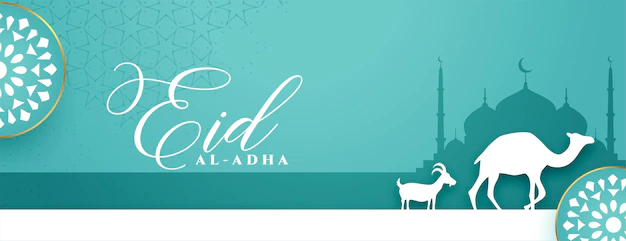The history of Eid ul-Adha dates back thousands of years to the time of Prophet Ibrahim(AS) (Abraham AS), who is considered a revered figure in Islam, Christianity, and Judaism. According to Islamic tradition, Prophet Ibrahim (AS) experienced a vivid dream in which he was commanded by God to sacrifice his son, Ismail (AS) (Ishmael AS). Initially taken aback by this divine command, Ibrahim (AS) recognized it as a test of his faith and devotion.
Ibrahim (AS) was filled with love for God and devotion to His commands. He told his son Ismail (AS) about his dream of sacrificing him. Ismail (AS) agreed to his father’s choice, knowing the importance of their submission to God. When Satan tried to stop Ibrahim (AS) from doing the sacrifice, the prophet firmly rejected the devil’s whispers. Prophet Ismail (AS) comforted his father and encouraged him to follow the commands of Allah (SWT).
Oh my father," Ismail (as) told Ibrahim (as), “Do that which you have been commanded, Insha’Allah you shall find me among the patient ones." (37:102)
As Ibrahim (AS) raised the knife to sacrifice his son, Allah intervened and replaced Ismail (AS) with a ram, sparing his life. This act of divine intervention demonstrated the ultimate reward for unwavering faith and complete submission to God’s will. In recognition of this extraordinary act of obedience, Muslims around the world celebrate Eid ul-Adha, also known as the Feast of Sacrifice.

When Did Eid ul-Adha observed
Eid ul-Adha is observed on the 10th day of Dhu al-Hijjah, the twelfth and final month of the Islamic lunar calendar. This holiday marks the conclusion of the Hajj pilgrimage, one of the Five Pillars of Islam, which millions of Muslims undertake each year in the holy city of Mecca, Saudi Arabia. The completion of Hajj and the celebration of Eid ul-Adha symbolize unity, humility, and gratitude towards God.
Date of Eid ul-Adha 2023
How Muslims Celebrate Eid al-Adha
The celebrations of Eid ul-Adha begin with congregational prayers held at mosques and open spaces. Muslims gather in large numbers, dressed in their finest attire, to offer their prayers, seek forgiveness, and express gratitude for the blessings bestowed upon them. The sermon delivered during the prayers emphasizes the significance of sacrifice, compassion, and the importance of serving humanity.
After the prayers, families and friends come together to exchange greetings and share meals. A special feature of Eid ul-Adha is the act of Qurbani, which involves the sacrifice of a livestock animal, typically a goat, sheep, cow, or camel. The meat from the sacrificed animal is divided into three parts: one-third is shared with family and friends, another third is given to the needy, and the remaining third is kept for personal consumption.
WHAT WE CAN LEARN FROM THE STORY OF QURBANI
The act of Qurbani symbolizes Prophet Ibrahim’s (AS) sacrifice and serves as a reminder of the values of charity and empathy towards those less fortunate. It reinforces the Islamic principle of caring for the community and sharing blessings with others, promoting social harmony and solidarity.
Eid ul-Adha transcends cultural and geographical boundaries, fostering a sense of unity among Muslims worldwide. The celebrations vary from region to region, influenced by local customs and traditions. However, the core message of Eid ul-Adha remains constant: to commemorate the unwavering faith of Prophet Ibrahim and to inspire individuals to emulate his devotion to God.
Throughout history, Eid ul-Adha has been a time of reflection, spiritual renewal, and acts of benevolence. It serves as a reminder of the values that underpin the Islamic faith, such as sacrifice, obedience
How Is Eid al-Adha Different from Eid al-Fitr?
Two Eid festivals are celebrated by Muslims every year. The first one is Eid al-Fitr, which means “festival of the breaking of the fast” in Arabic. It happens at the end of Ramadan, a month when Muslims fast from sunrise to sunset every day. This is also called Sawm and it is one of the five pillars of the Islamic faith. Ramadan is the month when Allah revealed the first verses of the Quran to the Prophet Muhammad.
The second one is Eid al-Adha, which is usually regarded as the more sacred of the two Eid festivals. It occurs about two months after Eid al-Fitr at the end of the annual Hajj pilgrimage to Mecca. Both holidays have fixed dates according to the Islamic lunar calendar. However, they change every year in the Western 365-day Gregorian calendar because it is about 11 days longer.









